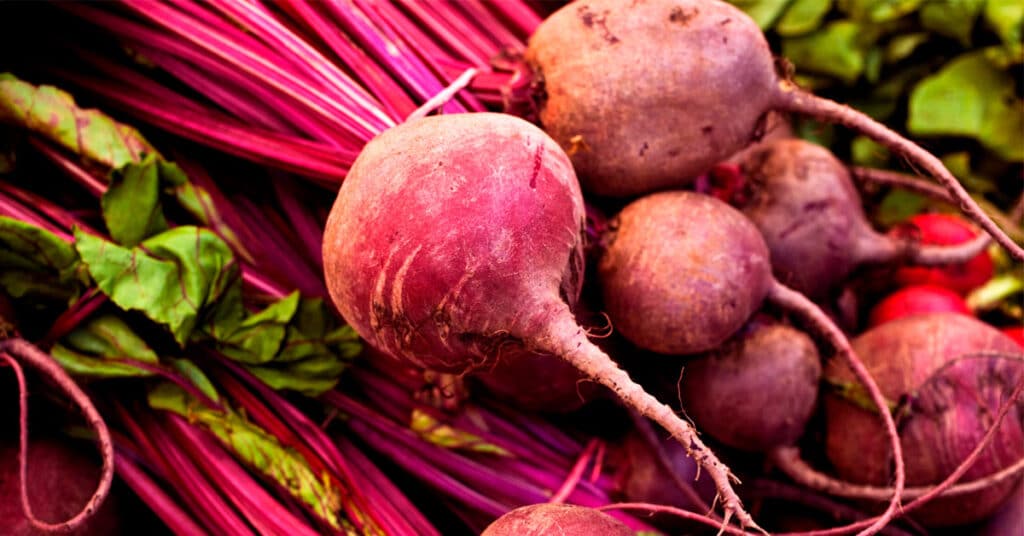

Nitric oxide (NO) is one of the most important molecules in the body, involved in virtually every organ system. Perhaps its most important role is as a potent vasodilator (i.e. it makes blood vessels bigger). This is of huge importance because bigger blood vessels means more blood flow around the body without the pump (heart) working harder. Thus, insufficient NO can directly cause or contribute to multiple diseases.
The discovery of NO, a structurally simple, colourless and odorless gas, was viewed as so fundamentally important for human health and disease prevention that Science magazine named it as molecule of the year in 1992, and the Nobel Prize in Physiology or Medicine was awarded for its discovery in 1998.
NO is produced by an enzyme for an amino acid called L-Arginine. L-Arginine is found in many protein containing foods (e.g. legumes and nuts). However, one problem is that the enzyme doesn’t always work well and can be affected by smoking, getting older, etc. Another problem is that simply supplying more L-Arginine, either in diet or supplements, does not always increase NO production. Even worse, L-arginine supplementation has been demonstrated to be ineffective after long-term use and has been associated with less NO[1] and excess death when given to patients after a heart attack.[2]
Despite intense interest, there are unfortunately very few options to enhance NO bioavailability, including medications and surgery. Then…enter vegetables! Until recently, it was assumed that the enzyme discussed above was the only way to produce NO in humans. As dietary components, both nitrate and nitrite were considered unfavourable and potentially cancer causing. However, it has been shown that when humans ingest dietary nitrate, it is recirculated into the saliva where bacteria in the mouth convert it to nitrite. This nitrite is swallowed and can be further converted into NO either in the stomach, blood vessels, or within tissues (e.g. heart).[3][4] Dietary nitrate is now recognised as a very significant precursor to NO in a dose-dependent manner in humans.[5] In other words, more nitrate equals more NO—though there is a plateau at very high doses. Therefore, ingestion of dietary nitrate may increase NO and provide benefit in a number of diseases characterised by insufficient NO.
The bacteria in the mouth are crucial because humans can’t convert nitrate to nitrite; only the bacteria can. Killing these bacteria by using mouthwash or antibiotics[6][7] has been shown to stop the production of NO from dietary nitrate! One study even got volunteers to consume nitrate and then drool and so lose the nitrate/nitrite in their saliva. This completely stopped the effect![4] Another important step in the production of NO from dietary nitrate is the acid within the stomach, which helps produce NO from nitrite. Therefore, decreasing stomach acid with certain medications (e.g. antacids and acid reducing medication like Losec) can also decrease NO production and its effects.[3]
Is nitrite harmful?
You may have heard of nitrite previously. Nitrite is often used as a preservative and added to processed meats (e.g. bacon) to prevent spoilage (e.g. botulism) and to contribute to a pinky color. Plant foods are the primary sources of nitrate, while processed and cured meats are the primary sources of nitrites for humans. Plant foods generally contain little or no nitrite, while animal foods, even if cured, generally contain little or no nitrate. Processed meats have multiple negative health consequences, and nitrite has been thought to be one of the reasons why. But dietary nitrate seems to work by first being metabolised to nitrite. Does this mean that dietary nitrate can be dangerous? It’s complicated!
When added to processed meats, nitrites can react with the iron, fat and amino acids present to form harmful substances before the meat is even cooked or eaten.[8][9] Further, it turns out that when humans consume nitrites, there is potential for additional cancer causing substances to form under certain conditions—for example, in the absence of phytochemicals and antioxidants The phyto– in phytochemical is Greek for “plant.” They are literally “plant chemicals. Phytochemicals and antioxidants are health promoting, disease fighting compounds found in abundance in whole plant foods. It seems that nitrite is not as much a problem as the nitrosamines formed when we eat nitrite in the form of processed meats. A review in the American Journal of Clinical Nutrition wrote that “If nitrite were, indeed, a carcinogen, we would be advised to avoid swallowing because saliva contains nitrite.”[10] On the other hand, when nitrate (often produced from dietary nitrate in plant foods) is available in the presence of antioxidants and phytochemicals, NO is produced. Guess what nitrate containing plant foods also contain in abundance. Phytochemicals and antioxidants!
Benefits of dietary nitrate
When humans ingest food we metabolise it in the presence of oxygen to produce a molecule called ATP (adenosine triphosphate). ATP produces energy at the cellular level. It has been thought that a certain and constant amount of oxygen was required to produce a molecule of ATP. Athletes, for example, can produce more ATP than non-athletes, but athletes have bigger, stronger lungs than non-athletes. They also have more oxygen carrying red blood cells and can take in more oxygen for ATP production.
Until recently, we knew very few ways to produce more ATP without increasing oxygen consumption. However, several trials have demonstrated that dietary nitrate can decrease the amount of oxygen need to produce ATP,[11] i.e.more work can be performed with the same amount of oxygen. There are also reports that dietary nitrate improves the efficiency of human mitochondria, the energy producing units within our cells.[12] Thus, dietary nitrates could prove to be beneficial for athletes, those living at high altitude (where oxygen is limited) and some disease states, such as lung disease or sleep disorders, where oxygen is limited.
Early studies demonstrated that dietary nitrate could even help improve performance in athletes.[11] However, recent evidence with regard to athletes has been very inconsistent. Nevertheless, the effect of dietary nitrate on those with lower fitness levels and/or muscular/heart/lung impairments is more convincing.[13] The effect of dietary nitrate on physical performance seems more pronounced in those with less fitness and with muscular/lung impairments.[13] I headed a research team in Dublin, and we demonstrated increase exercise tolerance in patients with a serious lung disease called COPD[14] and in those with a specific heart problem—non-ischemic, dilated cardiomyopathy.”[15] Other research groups around the world have also reported benefit in COPD, heart failure[16][17] and peripheral artery disease (also called intermittent claudication).[18]
High blood pressure is one of the most common and life threatening issues in the world. Because NO causes blood vessels to dilate, increasing NO can decrease blood pressure. Therefore, dietary nitrate could increase NO and decrease blood pressure. Indeed, early studies showed that dietary nitrate could decrease blood pressure in young, healthy volunteers.[19][20] More recent data show that dietary nitrate can also decrease blood pressure in more at-risk populations—those with high blood pressure.[21][23] My research team in Dublin demonstrated that any blood pressure lowering effect was more pronounced in those with higher blood pressure,[24] i.e. those who need it most!
One group of researchers wrote, “an additional strategy, based on intake of nitrate-rich vegetables, may prove to be both cost-effective, affordable and favourable for a public health approach to hypertension.”[22]
Obstructive sleep apnoea (OSA) is a serious sleep disorder where a person stops breathing regularly during sleep. Each time the person stops breathing, oxygen levels fall and the person will wake up, usually briefly. At the clinic in Dublin, I remember one lady who had an OSA score of 150: she had stopped breathing 150 times in a single night and each time for at least ten seconds! OSA is associated with high blood pressure which is very difficult to treat. My research team has also demonstrated that dietary nitrate can decrease blood pressure in OSA.[25]
Additional research has even shown that dietary nitrate can increase blood flow to the brain.[26] This brings the intriguing question: can increasing dietary nitrate help improve brain disorders such as dementia?
When trials relating to dietary nitrate first started being published, scientists were sceptical. How could vegetables increase NO when many other therapies couldn’t? How could dietary nitrate lower blood pressure and increase exercise capacity in multiple groups? Eventually the volume of research convinced the majority that vegetables were in fact very effective! A 2008 editorial in the eminent journal Hypertension led with the headline, “Mother was right: eat your vegetables and do not spit!”[27]
How can dietary nitrate affect so many processes?
Dietary nitrate increases NO production. Because NO is so important throughout the body, this means that nitrate can have wide ranging effects. Research has shown that dietary nitrate works by making blood vessels bigger, increasing the amount of blood with each heartbeat, increasing the amount of oxygen in muscles, and thus increasing muscle strength.
Who will benefit most?
In the scientific journal Current Opinion in Clinical Nutrition and Metabolic Care, I recently published a scientific review of the conditions that contribute to the effectiveness of dietary nitrate in increasing NO, lowering blood pressure, and improving exercise tolerance.[13]
Dietary nitrate may be most relevant to those with muscular, lung, or blood vessel impairments, for example low muscle mass, breathing problems, or high blood pressure. Increasing dietary nitrate also seems most beneficial in less fit individuals and those with a previously low dietary nitrate intake. Interestingly, longer term intake of dietary nitrate appears more beneficial than short term, i.e. regular consumption of green, leafy vegetables, for life! Finally, and perhaps most specific to athletes, dietary nitrate seems to be more effective in those engaging in short-term, intense exercise as opposed to longer term, low-moderate intensity.
How can I increase my nitrate intake?
Nitrate is present at trace levels in our environment, as well as in plant tissues. Therefore, all whole plant foods contain nitrate, though the levels vary depending on the type of plant and the quality of the soil in which it’s grown.
Vegetables are the main source of nitrate, contributing around 85 % of daily nitrate intake.[28]. Most of the remaining nitrate comes from drinking water. Analyses of a range of foodstuffs indicate that the highest levels occur in green, leafy vegetables such as cabbage, lettuce, chard, and particularly arugula (rocket), while beetroot and rhubarb are moderate sources. Other vegetables such as carrots contain lesser amounts.[29]
National dietary data surveys show average daily nitrate intakes in the USA and Europe to be 0.5-3 mmol/day).[30][21]. This low nitrate intake reflects low vegetable intake. However, vegetarian as well as traditional Mediterranean and Japanese diets and the DASH diet contain far more vegetables and hence more nitrate than standard Western diets,[32] with levels of up to 20 mmol/day being reported.
It is possible to get inorganic nitrate in a pharmaceutical form. However, the pharmaceutical form may have safety issues while nitrate from the diet does not. Additionally, nitrate from the diet has shown superior results,[13] possibly due to synergistic effect of phytochemicals and other antioxidants.
Factors known to affect nitric oxide generation from dietary nitrate
As stated above, more nitrate equals more NO,[5] and the dose of nitrate appears to be the most significant predictor of biochemical and physiological response to nitrate.[13] However, it should be noted that a threshold effect has been suggested. For example, one study reported no effect of 4.2mmol/day but higher doses of 8.4 and 16.8mmol/day improved exercise performance. However, 16.8mmol achieved no additional benefit compared to 8.4mmol/day.[33] Existing evidence suggests a maximum benefit of around 10 mmol/day, and this can easily be achieved with daily consumption of a variety of plant foods like green leafy vegetables, rhubarb, and beetroot. Other factors that can increase NO production from dietary nitrate include exercise and some medications (e.g. statins). Factors known to decrease NO production from dietary nitrate include smoking, aging, high cholesterol, inflammation, and low oxygen conditions (e.g. high altitude, some lung diseases).
The effects of dietary nitrate seem to be highest about three hours after consumption.[4] After this, there is still a benefit but the effect lessens. After 24 hours, the effect is mostly gone. Therefore, humans should ideally aim to eat nitrate rich foods at least once per day and possibly more. Eat vegetables every day…sound familiar?
Is dietary nitrate safe?
Although dietary nitrate (consumed as vegetables!) seems remarkably safe and remarkably effective, some caution is warranted. The American Academy of Pediatrics and American Academy of Pediatrics Committee does not recommend dietary nitrate for infants under three months of age.[34] Also, green vegetables contain vitamin K and are not recommended for those taking certain medications (e.g. Coumadin/Warfarin). Some sources of dietary nitrate (e.g. beetroot) can be high in oxalates, which can contribute to kidney stones in susceptible individuals. Many of the recent trials used beetroot juice as a convenient, standardised source of dietary nitrate. Beetroot consumption does have one interesting side effect: red/purple urine and stools! This is completely harmless, simply due to the colorful pigments in beetroot and affects about 15% of people. In fact, beetroot causing red/purple urine is so well known it has a medical term: beeturia!
Conclusion
Green, leafy vegetables are consistently reported as one of the healthiest varieties of plant foods, including with regards to protection against heart disease, diabetes, and cancer. Some have suggested that nitrate explains a lot of this benefit.[4][35][36] Either way, the practicalities are clear: For most people looking to optimize their NO levels and overall health, the consumption of green, leafy vegetables regularly as well as beetroot and rhubarb can be recommended.
References
- Wilson AM, Harada R, Nair N, Balasubramanian N, Cooke JP. L-arginine supplementation in peripheral arterial disease: no benefit and possible harm. Circulation. 2007 Jul 10;116(2):188-95. Epub 2007 Jun 25.
- Schulman SP, Becker LC, Kass DA, Champion HC, Terrin ML, Forman S, Ernst KV, Kelemen MD, Townsend SN, Capriotti A, Hare JM, Gerstenblith G. L-arginine therapy in acute myocardial infarction: the Vascular Interaction With Age in Myocardial Infarction (VINTAGE MI) randomized clinical trial. JAMA. 2006 Jan 4;295(1):58-64.Lundberg et al 1994;
- Lundberg JO, Weitzberg E, Lundberg JM, Alving K. Intragastric nitric oxide production in humans: measurements in expelled air. Gut. 1994 Nov;35(11):1543-6.
- Webb AJ, Patel N, Loukogeorgakis S, Okorie M, Aboud Z, Misra S, Rashid R, Miall P, Deanfield J, Benjamin N, MacAllister R, Hobbs AJ, Ahluwalia A. Acute blood pressure lowering, vasoprotective, and antiplatelet properties of dietary nitrate via bioconversion to nitrite. Hypertension. 2008 Mar;51(3):784-90. doi: 10.1161/HYPERTENSIONAHA.107.103523. Epub 2008 Feb 4.
- Bondonno CP, Croft KD, Puddey IB, Considine MJ, Yang X, Ward NC, Hodgson JM. Nitrate causes a dose-dependent augmentation of nitric oxide status in healthy women. Food Funct. 2012 May;3(5):522-7. doi: 10.1039/c2fo10206d. Epub 2012 Feb 16.
- Bondonno CP, Liu AH, Croft KD, Considine MJ, Puddey IB, Woodman RJ, Hodgson JM. Antibacterial mouthwash blunts oral nitrate reduction and increases blood pressure in treated hypertensive men and women. Am J Hypertens. 2015 May;28(5):572-5. doi: 10.1093/ajh/hpu192. Epub 2014 Oct 30.
- Bryan NS, Tribble G, Angelov N. Oral Microbiome and Nitric Oxide: the Missing Link in the Management of Blood Pressure. Curr Hypertens Rep. 2017 Apr;19(4):33. doi: 10.1007/s11906-017-0725-2. Review.
- Haorah J, Zhou L, Wang X, Xu G, Mirvish SS. Determination of total N-nitroso compounds and their precursors in frankfurters, fresh meat, dried salted fish, sauces, tobacco, and tobacco smoke particulates. J Agric Food Chem. 2001 Dec;49(12):6068-78.
- Campillo N, Viñas P, Martínez-Castillo N, Hernández-Córdoba M. Determination of volatile nitrosamines in meat products by microwave-assisted extraction and dispersive liquid-liquid microextraction coupled to gas chromatography-mass spectrometry. J Chromatogr A. 2011 Apr 8;1218(14):1815-21. doi: 10.1016/j.chroma.2011.02.010. Epub 2011 Feb 13.
- Hord NG, Tang Y, Bryan NS. Food sources of nitrates and nitrites: the physiologic context for potential health benefits. Am J Clin Nutr. 2009 Jul;90(1):1-10. doi: 10.3945/ajcn.2008.27131. Epub 2009 May 13. Review.
- Bailey SJ, Winyard P, Vanhatalo A, Blackwell JR, Dimenna FJ, Wilkerson DP, Tarr J, Benjamin N, Jones AM. Dietary nitrate supplementation reduces the O2 cost of low-intensity exercise and enhances tolerance to high-intensity exercise in humans. J Appl Physiol (1985). 2009 Oct;107(4):1144-55. doi: 10.1152/japplphysiol.00722.2009. Epub 2009 Aug 6.
- Larsen FJ, Schiffer TA, Borniquel S, Sahlin K, Ekblom B, Lundberg JO, Weitzberg E. Dietary inorganic nitrate improves mitochondrial efficiency in humans. Cell Metab. 2011 Feb 2;13(2):149-59. doi: 10.1016/j.cmet.2011.01.004.
- Kerley CP. Dietary nitrate as modulator of physical performance and cardiovascular health. Curr Opin Clin Nutr Metab Care. 2017 Nov;20(6):440-446. doi: 10.1097/MCO.0000000000000414.
- Kerley CP, Cahill K, Bolger K, McGowan A, Burke C, Faul J, Cormican L. Dietary nitrate supplementation in COPD: an acute, double-blind, randomized, placebo-controlled, crossover trial. Nitric Oxide. 2015 Jan 30;44:105-11. doi: 10.1016/j.niox.2014.12.010. Epub 2014 Dec 19.
- Kerley CP, O’Neill JO, Reddy Bijjam V, Blaine C, James PE, Cormican L. Dietary nitrate increases exercise tolerance in patients with non-ischemic, dilated cardiomyopathy-a double-blind, randomized, placebo-controlled, crossover trial. J Heart Lung Transplant. 2016 Jul;35(7):922-6. doi: 10.1016/j.healun.2016.01.018. Epub 2016 Jan 16. No abstract available.
- Coggan AR, Leibowitz JL, Spearie CA, Kadkhodayan A, Thomas DP, Ramamurthy S, Mahmood K, Park S, Waller S, Farmer M, Peterson LR. Acute Dietary Nitrate Intake Improves Muscle Contractile Function in Patients With Heart Failure: A Double-Blind, Placebo-Controlled, Randomized Trial. Circ Heart Fail. 2015 Sep;8(5):914-20.
- Zamani P, Rawat D, Shiva-Kumar P, Geraci S, Bhuva R, Konda P, Doulias PT, Ischiropoulos H, Townsend RR, Margulies KB, Cappola TP, Poole DC, Chirinos JA. Effect of inorganic nitrate on exercise capacity in heart failure with preserved ejection fraction. Circulation. 2015 Jan 27;131(4):371-80.
- Kenjale AA, Ham KL, Stabler T, Robbins JL, Johnson JL, Vanbruggen M, Privette G, Yim E, Kraus WE, Allen JD. Dietary nitrate supplementation enhances exercise performance in peripheral arterial disease. J Appl Physiol (1985). 2011 Jun;110(6):1582-91. doi: 10.1152/japplphysiol.00071.2011. Epub 2011 Mar 31.
- Hobbs DA, George TW, Lovegrove JA. The effects of dietary nitrate on blood pressure and endothelial function: a review of human intervention studies. Nutr Res Rev. 2013 Dec;26(2):210-22. doi: 10.1017/S0954422413000188. Epub 2013 Oct 18. Review.
- Siervo M, Lara J, Ogbonmwan I, Mathers JC. Inorganic nitrate and beetroot juice supplementation reduces blood pressure in adults: a systematic review and meta-analysis. J Nutr. 2013 Jun;143(6):818-26. doi: 10.3945/jn.112.170233. Epub 2013 Apr 17. Review.
- Ghosh SM, Kapil V, Fuentes-Calvo I, Bubb KJ, Pearl V, Milsom AB, Khambata R, Maleki-Toyserkani S, Yousuf M, Benjamin N, Webb AJ, Caulfield MJ, Hobbs AJ, Ahluwalia A. Enhanced vasodilator activity of nitrite in hypertension: critical role for erythrocytic xanthine oxidoreductase and translational potential. Hypertension. 2013 May;61(5):1091-102. doi: 10.1161/HYPERTENSIONAHA.111.00933. Epub 2013 Apr 15.
- Kapil V, Khambata RS, Robertson A, Caulfield MJ, Ahluwalia A. Dietary nitrate provides sustained blood pressure lowering in hypertensive patients: a randomized, phase 2, double-blind, placebo-controlled study. Hypertension. 2015 Feb;65(2):320-7. doi: 10.1161/HYPERTENSIONAHA.114.04675. Epub 2014 Nov 24
- Kerley CP, Cormican L, James PE, Dolan, E. Dietary nitrate lowers ambulatory blood pressure in treated, uncontrolled hypertension: a 7d, double-blind, randomized, placebo-controlled, crossover trial.
- Kerley CP, Dolan E, Cormican L. Nitrate-rich beetroot juice selectively lowers ambulatory pressures and LDL cholesterol in uncontrolled but not controlled hypertension: a pilot study. Ir J Med Sci. 2017 Nov;186(4):895-902.
- Kerley CP, Dolan E, Cormican L. Dietary nitrate decreased blood pressure in obstructive sleep apnoea syndrome: a series of N-of-1 trials. J Hypertens. 2016 Apr;34(4):808-10. doi: 10.1097/HJH.0000000000000858. No abstract available.
- Presley TD, Morgan AR, Bechtold E, Clodfelter W, Dove RW, Jennings JM, Kraft RA, King SB, Laurienti PJ, Rejeski WJ, Burdette JH, Kim-Shapiro DB, Miller GD. Acute effect of a high nitrate diet on brain perfusion in older adults. Nitric Oxide. 2011 Jan 1;24(1):34-42. doi: 10.1016/j.niox.2010.10.002. Epub 2010 Oct 15.
- Wink DA, Paolocci N. Mother was right: eat your vegetables and do not spit! When oral nitrate helps with high blood pressure. Hypertension. 2008 Mar;51(3):617-9. doi: 10.1161/HYPERTENSIONAHA.107.106617. Epub 2008 Feb 4. No abstract available.
- Lundberg JO, Weitzberg E, Gladwin MT. The nitrate-nitrite-nitric oxide pathway in physiology and therapeutics. Nat Rev Drug Discov. 2008 Feb;7(2):156-67.
- Chan TY. Vegetable-borne nitrate and nitrite and the risk of methaemoglobinaemia. Toxicol Lett. 2011 Jan 15;200(1-2):107-8. doi: 10.1016/j.toxlet.2010.11.002. Epub 2010 Nov 12.
- Gangolli SD, van den Brandt PA, Feron VJ, Janzowsky C, Koeman JH, Speijers GJ, Spiegelhalder B, Walker R, Wisnok JS. Nitrate, nitrite and N-nitroso compounds. Eur J Pharmacol. 1994 Nov 1;292(1):1-38. Review.
- Mensinga TT, Speijers GJ, Meulenbelt J. Health implications of exposure to environmental nitrogenous compounds. Toxicol Rev. 2003;22(1):41-51. Review.
- Sobko T, Marcus C, Govoni M, Kamiya S. Dietary nitrate in Japanese traditional foods lowers diastolic blood pressure in healthy volunteers. Nitric Oxide. 2010 Feb 15;22(2):136-40. doi: 10.1016/j.niox.2009.10.007. Epub 2009 Nov 1
- Wylie LJ, Mohr M, Krustrup P, Jackman SR, Ermιdis G, Kelly J, Black MI, Bailey SJ, Vanhatalo A, Jones AM. Dietary nitrate supplementation improves team sport-specific intense intermittent exercise performance. Eur J Appl Physiol. 2013 Jul;113(7):1673-84. doi: 10.1007/s00421-013-2589-8. Epub 2013 Feb 1.
- Greer FR, Shannon M; American Academy of Pediatrics Committee on Nutrition; American Academy of Pediatrics Committee on Environmental Health. Infant methemoglobinemia: the role of dietary nitrate in food and water. Pediatrics. 2005 Sep;116(3):784-6.
- Lundberg JO, Feelisch M, Björne H, Jansson EA, Weitzberg E. Cardioprotective effects of vegetables: is nitrate the answer? Nitric Oxide. 2006 Dec;15(4):359-62. Epub 2006 Mar 24.
- Ralt D. Does NO metabolism play a role in the effects of vegetables in health? Nitric oxide formation via the reduction of nitrites and nitrates. Med Hypotheses. 2009 Nov;73(5):794-6. doi: 10.1016/j.mehy.2009.03.049. Epub 2009 May 27.
Copyright 2025 Center for Nutrition Studies. All rights reserved.
Deepen Your Knowledge With Our
Plant-Based Nutrition
Certificate
Plant-Based Nutrition Certificate
- 23,000+ students
- 100% online, learn at your own pace
- No prerequisites
- Continuing education credits











